A better question is: What is the difference between shallow water exercise and deep water exercise?
- Pool Depth. In shallow water the exerciser is standing in water that comes somewhere between waist level and chest level. At this depth, buoyancy supports 70% of the body’s weight. In deep water the exerciser is in water deep enough that the feet do not touch the pool floor. A flotation device must be worn so that the exerciser does not have to spend the entire class trying to keep her head above water. At this depth, buoyancy supports 90% of the body’s weight.
- Maintaining Alignment. Exercise is safest when performed in neutral alignment. In shallow water, water currents may challenge balance, but the exerciser’s feet are on the floor and her center of gravity (in the pelvic girdle) is the same as on land. In deep water the exerciser has to balance from her center of buoyancy (at the lungs) with no information from her feet to tell her where she is in space. It takes some practice, but the payoff is that core strength and posture both improve.
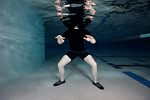
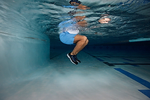
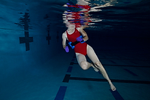 Working position. The working positions in shallow water are upright with rebound, upright grounded (keeping one foot in contact with the floor at all times), neutral (with the hips and knees flexed and the feet touching the floor) (see Photo 1), and suspended (see Photo 2). The working positions in deep water include upright, tilted 45 degrees to the side (see Photo 3), seated as if in a dining room chair, and side-lying.
Working position. The working positions in shallow water are upright with rebound, upright grounded (keeping one foot in contact with the floor at all times), neutral (with the hips and knees flexed and the feet touching the floor) (see Photo 1), and suspended (see Photo 2). The working positions in deep water include upright, tilted 45 degrees to the side (see Photo 3), seated as if in a dining room chair, and side-lying.- Travel. Travel in shallow water mainly involves the legs. In deep water, travel significantly involves the upper body. With no floor to push off from, the exerciser frequently uses arm movements to assist in travel, which requires a certain amount of upper body strength.
- Increasing Intensity. Exercisers can increase intensity in shallow water by increasing speed, by increasing the range of motion, by using acceleration off the pool floor (jumping), by using acceleration against the water’s resistance (power moves) and by traveling. Suspended moves also increase intensity for some, alth
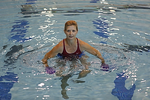 ough not so much for people who float easily. The same methods can increase intensity in deep water with the exception of jumping and suspended moves. In addition, deep water exercisers can elevate the shoulders out of the water with powerful leg moves or with sculling (see Photo 4). High intensities can be achieved in both shallow water and deep water.
ough not so much for people who float easily. The same methods can increase intensity in deep water with the exception of jumping and suspended moves. In addition, deep water exercisers can elevate the shoulders out of the water with powerful leg moves or with sculling (see Photo 4). High intensities can be achieved in both shallow water and deep water.
These are some of the differences between shallow and deep water exercise. Which is more interesting to you?
For more information about shallow and deep water, see my book Water Fitness Lesson Plans and Choreography. Information about the book is available on my website at www.waterfitnesslessons.com The photos illustrating this article come from the book.

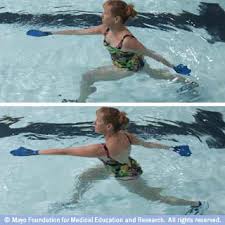
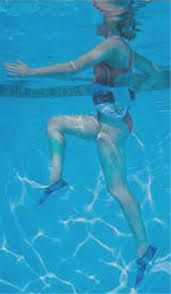
Thank you for such a comprehensive explanation of the differences between exercising in shallow and deep water. Really helpful.
If some one needs an expert view on the topic of writing a blog, I recommend they pay a visit this
website. Keep up the nice work.